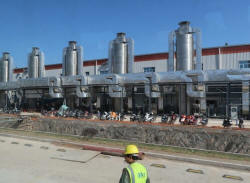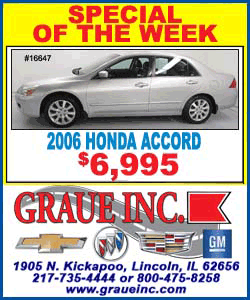|
Power surge: Chinese
electric car battery maker charges for global market
 Send a link to a friend
Send a link to a friend
 [December 26, 2016]
By Jake Spring [December 26, 2016]
By Jake Spring
NINGDE,
China (Reuters) - A dusty village on the outskirts of Ningde, a
third-tier city in China's southeast, seems an unlikely place for the
headquarters of a potential global leader in future automotive
technology.
Yet China's top-down industrial policy diktats - move up the value
chain, clean up polluted urban skies, and shift to plug-in cars - have
Contemporary Amperex Technology Ltd (CATL) poised to go from hometown
hero to national champion, and beyond.
China's answer to Japan's Panasonic Corp and South Korea's LG Chem Ltd
has tripled its production capacity for lithium-ion car batteries in the
past year to keep up with a surge in China's sales of electric cars.
After a second major funding round completed in October, the company's
value quadrupled to 80 billion yuan ($11.5 billion), CEO Huang Shilin
said last week.
CATL, which hopes to list on Beijing's over-the-counter exchange as part
of plans to raise at least another 30 billion yuan by 2020, could be a
dominant force globally.
It has already overtaken LG Chem in lithium-ion car battery output, and
is chasing down Panasonic and Warren Buffett-backed BYD Co Ltd.

CATL plans to grow its battery capacity sixfold by 2020 to 50 gigawatt
hours, which could put it ahead of Tesla Motor Inc's gigafactory in
Nevada.
"We continue to walk where the country guides us," Huang said. "We hope
by 2020 we can achieve performance and price that lead the world."
The company, founded just five years ago, is already pushing beyond
China's borders, with offices in Sweden, Germany and France and plans to
build a factory in Europe. Company representatives say that because of
non-disclosure agreements they can only list BMW as a customer for now.
Despite the ambitious expansion, the emerging segment's dependence on
government policy and rapidly evolving technology is not without risk.
A123, a U.S. automotive battery maker, went from IPO to bust in just
three years as battery costs remained stubbornly high and orders dried
up.
"People think we're a big successful company, but we think we're in
jeopardy every day," marketing director Neill Yang said. "The market
environment and technology changes so fast that if we don't follow the
trend we could die in three months."
BUILDING A CHAMPION
To become a Chinese champion, a battery maker must first shed any
foreign investment to be eligible for subsidies and other policy
support, people in the industry say.
Before he set up CATL, Robin Zeng had started Amperex Technology Ltd (ATL),
a company now majority-owned by Japan's TDK.

ATL initially had a 15 percent stake in CATL, but liquidated that
holding last year, Yang said, when electric vehicle sales first started
to take off. He declined to elaborate on the circumstances of that
divestment.
TDK separated from CATL to focus on batteries for mobile consumer
electronics, but still collects royalties on some intellectual property
used by CATL, a spokesman for the Japanese company said.
[to top of second column] |

A worker stands outside a factory of Contemporary Amperex Technology
Ltd (CATL) in Ningde, Zhejiang province, China, December 16, 2016.
Picture taken December 16, 2016. REUTERS/Jake Spring

"The
reason is strategic and confidential. ATL still keeps a close relationship with
CATL," said a person familiar with the situation, who was not authorized to
speak to the media.
ATL and CATL still share a Ningde campus, although the front gate and main
office bear only the ATL name.
Zeng, a Ningde local with a doctorate in chemistry, appears to be the remaining
link between the two companies he founded. He declined an interview request.
POLICY SUPPORT
While government support for electric cars has driven demand for components such
as batteries, Beijing is also rolling out other policies that could benefit
leading producers like CATL, by forcing smaller firms to consolidate or go out
of business.
The Ministry of Industry and Information Technology (MITI) said last month it is
considering a rule that would increase minimum production requirements for
battery makers by around 40 times to 8 gigawatt hours.
Only BYD and CATL are roughly in line with that minimum, though Chinese media
reports suggest Hefei Guoxuan High-Tech Power Energy Co Ltd and Tianjin Lishen
Battery Joint-Stock Co Ltd may be close to or above that level by next year.
Yang said subsidy support for batteries is fairly modest compared to those for
producing electric vehicles, which totaled $4.5 billion last year alone.
CATL
has been nominated as one of three battery makers - with Guoxuan and Lishen -
for incentives under China's 13th Five-Year Plan, promising around $15 million
if it can meet targets, Yang said. He noted, though, that a single production
line costs $40 million.
Among national 2020 targets: to halve battery costs to below 1 yuan ($0.144) per
kilowatt hour, and improve energy density by two-thirds.

To get there, CATL is ramping up spending on research and development, where it
employs more than 1,000 people with advanced science degrees.
"The strength of their R&D investment is quite large," said Fu Yuwu, chief of
the Society of Automotive Engineers of China, adding he hopes the company can
become a global leader.
"They have such large scale and the support of China's huge market, all the more
reason they should do a good job of internationalizing," he said.
(Reporting by Jake Spring, with additional reporting by Sijia Jiang in HONG
KONG, Norihiko Shirouzu in BEIJING and Adam Jourdan in SHANGHAI; Editing by Ian
Geoghegan)
[© 2016 Thomson Reuters. All rights
reserved.] Copyright 2016 Reuters. All rights reserved. This material may not be published,
broadcast, rewritten or redistributed. |